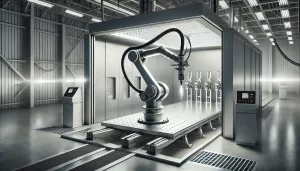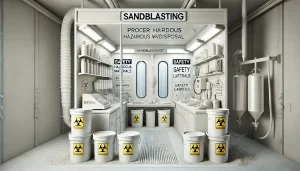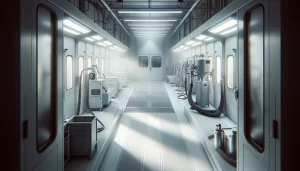When it comes to finishing surfaces in various industries, two common techniques stand out: liquid coating and powder coating. These methods are used to apply a protective or decorative finish to metal, wood, plastic, and other materials. While both serve the same general purpose, they have distinct differences in application, performance, environmental impact, and cost. Today, we’ll dive into what sets liquid and powder coating apart in a way that’s simple and easy to understand.
Application Methods: A Key Distinction
The most notable difference between liquid and powder coating lies in how each is applied.
Liquid Coating
As the name suggests, liquid coating uses a liquid form of paint. It typically involves spraying the coating onto a surface using a spray gun, brush, or roller. The coating is made up of pigments, solvents, and binders, which evaporate during the drying process, leaving behind a thin, smooth film. Because it flows easily, liquid coating can be used on intricate surfaces, small crevices, and oddly shaped objects.
Powder Coating
Powder coating is a dry finishing process that involves applying a fine powder to a surface. The powder, usually made of resin or polymer, is charged electrostatically so that it sticks to the surface being coated. After the powder is applied, the part is heated in an oven, causing the powder to melt and form a uniform, durable finish. This method is often preferred for its ability to produce a thick, even coating without running or sagging, which can happen with liquid coatings.
Durability and Performance
In terms of performance, both liquid and powder coatings are designed to protect surfaces from corrosion, chemicals, and wear, but they differ in their durability.
Liquid Coating
Liquid coatings offer good protection but tend to be thinner than powder coatings, making them somewhat less resistant to wear and impact over time. However, liquid coatings are often more flexible, which makes them ideal for surfaces that might bend or shift. Liquid coatings are also excellent at providing a smooth, high-gloss finish that some industries, like automotive, prefer for aesthetic reasons.
Powder Coating
Powder coatings are generally more durable than liquid coatings, as they can be applied in thicker layers without dripping. The thickness of the coating makes it highly resistant to chipping, scratching, and other forms of wear. Powder coating is also more resistant to chemicals and harsh environmental conditions, making it a popular choice for outdoor equipment, industrial machinery, and metal furniture.
Environmental Impact
Another major difference between the two types of coatings is their impact on the environment.
Liquid Coating
Traditional liquid coatings contain solvents, which can release volatile organic compounds (VOCs) into the air during the drying process. VOCs contribute to air pollution and pose health risks, which is why the use of solvent-based coatings is more regulated today. Some liquid coatings have been formulated to be more environmentally friendly, using water-based solutions instead of solvent-based ones, but these coatings still tend to produce more emissions compared to powder coatings.
Powder Coating
Powder coating is considered a much more environmentally friendly option. Since it doesn’t contain solvents, it produces virtually no VOCs. Additionally, any powder that doesn’t adhere to the surface during application can be collected and reused, reducing waste. This makes powder coating an eco-friendlier choice for companies looking to reduce their environmental footprint.
Aesthetic Flexibility and Finish Options
Both liquid and powder coatings offer a range of finish options, but the specific looks they can achieve differ slightly.
Liquid Coating
Liquid coatings offer a wider range of finishes, from high gloss to matte, and are available in a broader spectrum of colors. They can also be layered more easily, allowing for unique visual effects like metallics, gradients, and translucent finishes. For industries where aesthetics are crucial—such as in the production of cars, furniture, or electronics—liquid coatings may be the better choice for achieving specific looks.
Powder Coating
While powder coatings offer fewer options for finishes, they still provide plenty of choices. Textured finishes, for example, are more easily achieved with powder coating than with liquid coating. The thick, uniform finish produced by powder coating often has a slightly orange-peel texture, but smoother finishes can also be achieved with proper preparation and application. While powder coating may not offer the same range of visual effects as liquid coating, its durability and vibrant colors are enough for many applications.
Cost Considerations
Cost is a significant factor when choosing between liquid and powder coating, but the expenses involved can vary depending on the scale of the project.
Liquid Coating
Liquid coatings tend to be less expensive upfront, especially for smaller jobs that don’t require specialized equipment. However, over time, the cost can add up due to the need for multiple coats and touch-ups. Additionally, liquid coating jobs can create more waste, which adds to both material costs and disposal fees.
Powder Coating
Powder coating may have a higher initial cost, primarily due to the equipment required for application and curing. However, in the long run, powder coating can be more cost-effective because of its durability and minimal waste. The ability to reuse excess powder means less material is wasted, and the thicker, more durable finish requires fewer touch-ups over time.
The Bottom Line: Which Coating is Right for You?
When deciding between liquid and powder coating, there’s no one-size-fits-all answer. Each has its own set of advantages, and the choice often depends on the specific needs of the project.
- Choose Liquid Coating If: You need a highly detailed, smooth finish with flexibility in terms of aesthetics and colors. Liquid coating is ideal for surfaces with complex shapes and for industries where appearance is a priority, like automotive and consumer electronics.
- Choose Powder Coating If: Durability and environmental concerns are your top priorities. Powder coating offers a thicker, tougher finish that stands up to heavy use and harsh environments. It’s a great choice for outdoor furniture, industrial equipment, and situations where corrosion resistance is crucial.
Understanding the differences between liquid and powder coating can help you make a more informed decision for your business or project. Whether you prioritize durability, aesthetic flexibility, or environmental impact, each coating method has its strengths. Whichever you choose, be sure to consult with professionals who can guide you through the selection and application process to ensure the best results.
How We Can Help with Your Paint Booth Needs
At Paint Booth, we specialize in providing top-tier paint booths and finishing equipment tailored to your business requirements. Whether you need a standard-size paint booth or a custom solution designed for your unique projects, our expert team is here to assist you every step of the way. From design to installation, we ensure that your equipment meets the highest industry standards, enhancing both your productivity and the quality of your finishes. Contact us today to find the perfect paint booth solution for your business!




